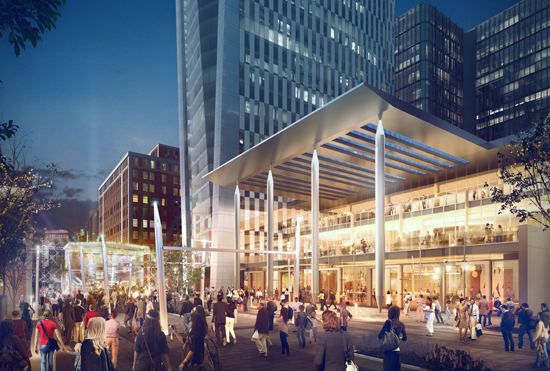Subscriber Benefit
As a subscriber you can listen to articles at work, in the car, or while you work out. Subscribe NowCity leaders could strike a deal with a local developer in the coming months to delay one of the two massive hotels planned for Pan Am Plaza.
The city has spent the past several weeks negotiating with Kite Realty Group Trust on the redevelopment project, which is to include a $120 million, publicly funded expansion of the Indiana Convention Center and two privately funded Hilton-brand hotels totaling more than 1,400 rooms. One factor in negotiations has been the development timeline, and whether it’s best to move forward with both hotels and the convention center expansion all at the same time as originally planned.
A delay could be welcome news to some critics of the project, who say adding so many rooms at once could overwhelm the downtown market. White Lodging Services Corp., which owns and operates several downtown hotels, including the JW Marriott, said in a written statement it is “pleased the [Capital Improvement Board] is re-thinking its ill-considered plan” for the Pan Am hotels, but said the board is “still missing the mark.”
On Thursday, Bruce White, chairman of White Lodging, said his company's projects planned for downtown Indianapolis are on hold “until we figure out what’s going on at Pan Am Plaza.” Those plans include the development of a new Marriott-brand Moxy boutique hotel in the 100 block of South Meridian St. The hotel, aimed at younger millennials, would likely include fewer than 200 rooms, White said.
He said he would like to see the Kite project scrapped and rethought completely, “as something that will be synergistic and create additional development, as opposed to destroy existing development.”
City officials, though, have warmed lately to splitting the Pan Am project into two distinct phases, with some expressing concern that adding all the rooms at once might negatively affect the downtown hotel occupancy rate, which sits around 70%.
The city is determined to finalize a project agreement by year’s end, but has had to manage challenges in recent months. Those include questions over the economic feasibility of the project, the expected boom in hotels in the market and heavy scrutiny from a group of downtown hotel owners.
Capital Improvement Board President Melina Kennedy confirmed the possible phasing of the project, but said “no final decisions have been made” on whether the city will take that route. She said officials are prepared to “move forward with the 800 initial” rooms, but are still evaluating plans for the other hotel.
If the project were split, the first phase would likely include the convention center expansion—comprised of a 50,000-square-foot ballroom and several smaller meeting spaces—and an 814-room, 38-story Hilton Signia.
The second hotel would be added later. It was proposed to have 600 rooms, although Kennedy said that number might fluctuate.
City officials are open to discussing the room count for the second phase, she said, “but not at the expense of the entire project, which we’re very committed to.”
The timetable for when Phase 2 would begin has not been determined, though a source said it could be anywhere from several months to a few years after the Signia opens.
Kite Realty Group officials declined to comment on the project.
Visit Indy officials have repeatedly said they believe both hotels are “crucial” for the growth of the city, with big-name convention groups like GenCon and Future Farmers of America signing deals to stay in town on the condition the expansion project moves forward.
“We have complete confidence in the city, the CIB and their negotiations with the developer on what's best for Indianapolis,” said Visit Indy Vice President Chris Gahl.
He said the convention and tourism bureau’s research shows the city can withstand the large influx in rooms expected from both hotels, but noted Visit Indy would support phasing in the project.
“We want to do what's best for Indianapolis,” Gahl said. “And if that's phasing the second hotel in slightly behind the building of the first, we’re supportive of that.”
Industry experts estimate 1,500 to 1,800 hotel rooms could come online in downtown Indianapolis in the next few years even without the Pan Am project. That number is likely to drop if the project moves forward, as other developers reject the market in favor of cities that could prove more viability for smaller projects.
The CIB awarded Kite the expansion project in October. The company already controls the project site; it acquired Pan Am Plaza several years ago for a similar-but-later-abandoned hotel project, and acquired the underground parking garage at the plaza for $30 million earlier this year.
While the developer’s plans were initially lauded, Kite’s proposal has come under fire by downtown hotel owners who don’t believe the 1,400 additional rooms are sustainable.
The group campaigned against the hotels for more than a month when the project was tied to a funding bill for the CIB that made its way through the Indiana Statehouse.
In Thursday's statement, White Lodging said its primary points of concern were the expected growth in hotels, as well as the likelihood the city will offer tax breaks or other incentives for the project—something White Lodging's JW Marriott hotel benefited from when it was built ahead of the 2012 Super Bowl.
“We encourage the CIB to pause all planning for hotel subsidies until a broader discussion with critical stakeholders and experts can be completed,” the statement said.
Mayor Joe Hogsett’s chief of staff, Thomas Cook, told IBJ in April the city is “not considering in any way, shape or form a direct subsidy” for Kite.
Opponents consider the city’s $120 million investment in the convention center expansion a developer subsidy, because the project will be developed by Kite and the two hotels will be able to utilize the connected meeting space and infrastructure.
Please enable JavaScript to view this content.

